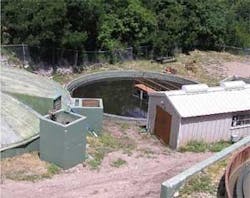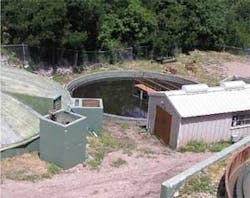Pioneering Water Reuse in the Old West
An integrated water conservation, indirect potable reuse project in New Mexico uses advanced membrane technology to supplement scarce water supplies with treated wastewater effluent.
The small New Mexico village of Cloudcroft — east of Alamogordo — holds more than one distinction. At 9,000 feet elevation, it’s home to the nation’s highest golf course. But being at the cutting edge in addressing a water shortage really makes Cloudcroft stand out. The local populace agreed to implement an integrated water conservation and indirect potable reuse project with advanced membrane technology to supplement an existing raw water source of spring and well water with treated wastewater effluent. Faced with a drought requiring 20,000 gallons of water to be trucked up the mountain daily during the peak summer tourism season, the nearly 1,000 residents quickly let go of any concerns about using recycled wastewater. From a $10 million state initiative to promote innovative water conservation, the village got $600,000 in 2004 to help fund its new $2 million water reuse system.
The state–of–the–art system employs a second–generation membrane bioreactor (MBR) and a gravity–fed reverse osmosis (RO) system to treat wastewater flows that ultimately exceed drinking water quality standards. Treated effluent is discharged largely into a man–made reservoir rather than pumped into a larger body of water such as an aquifer, river, lake or ocean. What makes Cloudcroft unusual is that this reservoir serves as a source for the town’s drinking water treatment system. Essentially, it’s noteworthy for shortening the distance — with an obvious path — from the wastewater treatment discharge point to the intake of the potable water treatment system.
Public acceptance
Benefits of water recycling are clear — the village’s water needs are met through an energy–efficient sustainable process that reduces water pollution, but the question arises: Why don’t more water–strapped communities implement similar systems? The answer may have as much to do with public attitudes as with water treatment science.
In the old joke about four friends at a bar, the optimist says “the glass is half full,” the pessimist says, “the glass is half empty,” the accountant says, “the glass is twice as big as it needs to be,” and the water engineer says, “the glass contains billions of molecules — fascinating pieces of history that have each taken a remarkable 4.4 billion year journey going back to the formation of planet Earth.” The problem is that unlike the water engineer, most people don’t like to think in much detail about the history of their drinking water.
At Cloudcroft, the concerns are understandable, as the new drinking water’s origin is clearly identifiable, the intervening time is relatively short, and the proportion of recycled water is relatively high. The purified wastewater constitutes up to 50% of the drinking water supply. Effluent from the reclaimed wastewater treatment plant (RWTP) is pumped into the reservoir, where it’s mixed with well and spring waters. Prior to intake into the potable water treatment system, the reservoir water is stored an average of 30 days for natural treatment by diffusion and sunlight. Use of an artificial reservoir, and blending with well and spring waters, classifies the Cloudcroft integrated water treatment system as an “indirect planned potable reuse” system.
While the public has general concerns about water reuse, water engineers recognize wastewater also contains pathogens and other emerging pollutants of concern (EPOC), including pharmaceutically–active substances, endocrine disrupters, and personal care products. For these reasons, it was felt that a multiple membrane barrier solution was a good choice. Livingston Associates, of Alamogordo, performed engineering design for the project. Key elements of the system are the MBR and RO membranes supplied by Koch Membrane Systems (KMS). These membranes, to be installed in the RWTP, will make the effluent discharged into the reservoir safe for human consumption. The integrated water treatment process also includes an ultrafiltration (UF) system to treat the reservoir water, an increasingly common treatment method for treating surface water.
Second generation MBR
The project involves conversion of the original wastewater treatment plant (WWTP) to an MBR process designed for an average flow of 100,000 gpd, with room for an additional 100,000 gpd in the future. The pre–existing 200,000–gallon equalization basin (EQ) is being retrofitted for the MBR process by being divided into two compartments: a 100,000–gallon basin for flow equalization and the remaining 100,000–gallon basin for the MBR. Raw wastewater influent will enter the system and pass through a 1–mm rotating drum screen at the existing headworks. Screened influent will flow by gravity to the EQ basin, before being pumped into the anoxic basin. From there, the flow enters the aeration basin for aerobic treatment, and then enters the four membrane chambers that house PURON™ submerged membrane modules from KMS. The second generation MBR system will produce a high quality effluent with turbidity typically less than 0.2–NTU (or 1.0–mg/L TSS). Filtrate will be disinfected with chloramines and pumped to a new 75,000–gallon water storage tank at the RWTP site. A key advantage to this MBR design is use of a single header with hollow fibers fixed only at the bottom. Sealed upper ends of the fibers are allowed to float freely. The free floating membrane tip eliminates build–up of hair and fibrous materials that can clog the upper end of membrane fibers in MBR designs that employ both a top and bottom header. Solids and particulates, including bacteria, are rejected by the membrane and remain on the outside, while permeate is drawn through the membrane to the inside of the fibers. Outside–to–inside technology such as this provides optimal solids management and a high flow–rate, while using up to 50% less energy than other MBR systems. Another advantage of the PURON design is introduction of air scour at the center of the fiber bundle, right where it’s needed. Compressed air creates bubbles that shake the membranes and scour the outside of the hollow fibers, removing accumulated debris. The unique air scour design is a vast improvement over older technology since it minimizes sludging around the membrane and cuts energy consumption. High–strength fibers in the modules also overcome fiber breakage problems typical of first generation systems that utilize non–braided fibers. The single header design also places less mechanical stress on the fibers compared to double–header designs. And, unlike flat sheet membranes that don’t support backflushing, these modules resist fouling and maintain flux by introducing a small portion of the filtrate back through the fiber pores from the inside–out at timed intervals. The hollow fibers provide higher membrane surface area, and thus higher filtration capacity within the same module footprint, compared to flat sheet designs.
Pure water from RO
The MBR is the first step in a multiple physical–barrier approach to reclaimed water repurification. The high–quality MBR permeate will be pumped uphill into a 75,000–gallon storage tank. From there, some water will be diverted for non–potable reuse (i.e., to irrigate the golf course and high school athletic fields). Each day, 100,000 gallons will flow downhill about 2.5 miles to the water treatment facilities that house the RO system. The force of gravity produces about 175 psi of residual pressure at the terminus of the 4–inch waterline — the pressure required to operate the RO system. The RO system is a single train, three–stage, one–pass system with five pressure vessels set up in an 2:2:1 array with Magnum® 8822HR membranes also from KMS. These high–rejection, low–pressure thin–film composite membranes have been successfully utilized in a number of reuse applications, and they’ve been shown to be effective in rejecting many emerging contaminants while achieving water recovery of about 80%. The RO system will produce an average of 80,000 GPD of permeate, with a TDS of about 50–mg/L from a feed quality of around 1,000 mg/L TDS. Permeate will receive peroxide and UV disinfection and be discharged into a 1,000,000–gallon lined and covered reservoir. From there, the reservoir water will flow into a 750,000–gallon covered and lined reservoir to blend with existing ground and spring waters. A portion will be used for aquifer recharge during low water demand. RO concentrate will be diverted to a 250,000–gallon open and lined reservoir along with UF backwash water. This is to be used for road dust control, construction, snow making for the ski area, gravel mining operations, forest fire fighting and other beneficial purposes.
High quality, safe drinking water
The final integrated treatment stage is ultrafiltration of reservoir water containing RO permeate, well and spring water. Each day, about 180,000 gallons of blended water will be treated via the UF system. Permeate will be filtered by granular activated carbon before added disinfection via sodium hypochlorite. Disinfected water then goes into the water distribution system. Since the high–quality (low TDS) water from the RO process is to be used for blending, overall water quality in the distribution system is expected to improve when Cloudcroft begins using reclaimed water. And that just goes to show it isn’t where the water has been that counts, but where it’s going. The multi–membrane system, and its multiple physical barriers, provides protection to give Cloudcroft residents and tourists confidence to enjoy high–quality, high–tech water as pure as a mountain stream.
For over 35 years, Koch Membrane Systems Inc. has manufactured innovative membrane filtration solutions. Based in Wilmington, Massachusetts, USA, it has over 15,000 systems installed worldwide, serving food processing, life sciences, and water and wastewater needs of industry and municipalities alike. Contact: +1–978–694–7000 or www.kochmembrane.com
